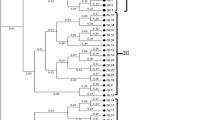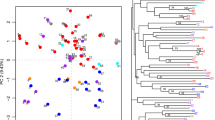Abstract
Forty-three wild cranberry (Vaccinium macrocarpon Ait.) clones collected from four Canadian provinces and five cranberry cultivars were assessed for genetic variability by using random amplified polymorphic DNA (RAPD)-PCR. Fourteen primers generated 161 polymorphic RAPD-PCR bands. A substantial degree of genetic diversity was found among the wild cranberry collections. Cluster analysis by the unweighted pair-group method with arithmetic averages (UPGMA) separated the wild clones and three cultivars into five main clusters, and identified the two remaining cultivars as outliers. Furthermore, within four clusters, the genotypes tended to form sub-clusters that were in agreement with the principal coordinate (PCO) analysis. Geographical distribution explained 10% of total variation as revealed by analysis of molecular variance (AMOVA). The RAPD markers detected a sufficient degree of polymorphism to differentiate among cranberry clones and cultivars, making this technology valuable for germplasm management and the more efficient choice of parents in current cranberry breeding programs.
Similar content being viewed by others
References
Adams R.P. and Rieseberg L.H. (1998). Theor. Appl. Genet. 97: 323–326
Albert T., Raspé O. and Jacquemart A.L. (2003). Clonal structure in Vaccinium mytrillus L. revealed by RAPD and AFLP markers. Int. J. Plant Sci. 164: 649–655
Albert T., Raspé O. and Jacquemart A.L. (2005a). Diversity and spatial structure of clones in Vaccinium uliginosum populations. Can. J. Bot. 83: 211–218
Albert T., Raspé O. and Jacquemart A.L. 2005b. Clonal diversity and genetic structure in Vaccinium myrtillus L. populations from different habitats. Belg. J. Bot. 137: 155–162.
Aldrich P.R. and Doebley J. (1992). Theor. Appl. Genet. 85: 293–302
Auge H., Neuffer B., Erlinghagen F., Grupe R. and Brandl R. (2001). Demographic and random amplified polymorphic DNA analyses reveal high levels of genetic diversity in a clonal violet. Mol. Ecol. 10: 1811–1819
Burgher K.L., Jamieson A.R. and Lu X. (2002). Genetic relationships among lowbush blueberry genotypes as determined by randomly amplified polymorphic DNA analysis. J. Am. Soc. Hort. Sci. 127: 98–103
Cahill J.P. (2004). Genetic diversity among varieties of chia (Salvia hispanica L.). Genet. Resour. Crop Evol. 51: 773–781
Caruso F.L. (1997). Trends in cranberry production. Acta Hort. 446: 41–45
Debnath S.C. (2000). Combined application of classical and biotechnological techniques in the development of small fruits important to Newfoundland and Labrador (Abstr.). Can. J. Plant Sci. 80: 233
Debnath S.C. (2005). Differentiation of Vaccinium cultivars and wild clones using RAPD markers. J. Plant Biochem. Biotech. 14: 173–177
Debnath S.C. and McRae K.B. (2001). An efficient in vitro shoot propagation of cranberry (Vaccinium macrocarpon Ait.) by axillary bud proliferation. In Vitro Cell Dev. Biol. Plant 37: 243–249
Debnath S.C. and McRae K.B. (2005). A one-step in vitro cloning procedure for cranberry (Vaccinium macrocarpon Ait.): the influence of cytokinins on shoot proliferation and rooting. Small Fruits Rev. 4: 57–75
Doyle J.J. and Doyle J.L. (1987). A rapid DNA isolation procedure from small quantities of fresh leaf tissues. Phytochem. Bull. 19: 11–15
Excoffier L., Smouse P. and Quattro J. (1992). Analysis of molecular variance inferred from metric distances among DNA haplotypes: application to human mitocondrial DNA restriction data. Genetics 131: 479–491
Galletta G.J. and Ballington J.R. (1996). Blueberries, cranberries and lingonberries. In: Janick, J. and Moore, J.N. (eds) Fruit Breeding Vol. II. Vine and Small Fruits, pp 1–107. John Wiley and Sons, Inc., New York
Gower J.C. (1966). Some distance properties of latent root and vector methods used in multivariate analysis. Biometrika 53: 325–338
Hedrick P. (1992). Shooting the RAPDs. Nature (London) 355: 679–680
Hong V. and Wrolstad R.E. (1990). Use of HPLC separation/photodiode array detection for characterization of anthocyanins. J. Agr. Food Chem. 38: 708–715
Hurka H. (1994). Conservation genetics and the role of botanic gardens. In: Loeschecke, V., Tomiuk, J. and Jain, S.K. (eds) Conservation Genetics, pp 371–380. Birkahuser Verlag, Basel
Kjølner S., Sastad S.M., Taberlet P. and Brochmann C. (2004). Mol. Ecol. 13: 81–86
Kreher S.A., Foré S.A. and Collins B.S. (2000). Genetic variation within and among patches of the clonal species, Vaccinium stamineum L. Mol. Ecol. 9: 1247–1252
Leahy M., Speroni J. and Starr M. (2002). Latest development in cranberry health research. Pharm. Biol. 40: 50–54
Nei M. and Li W.H. (1979). Mathematical model for studying genetic variation in terms of restriction endonucleases. Proc. Natl. Acad. Sci. USA 76: 5269–5273
Novy R.G., Vorsa N. and Patten K. (1996). Identifying genotypic heterogeneity in ‘McFarlin’ cranberry: a randomly-amplified polymorphic DNA (RAPD) and phenotypic analysis. J. Am. Soc. Hort. Sci. 121: 210–215
Nybom H. and Bartish I.V. (2000). Effects of life history traits and sampling strategies on genetic diversity estimates obtained with RAPD markers in plants. Perspect. Plant Ecol. Evol. Syst. 3: 93–114
Ortiz R. and Vorsa N. (2004). Transmission of a cyclical translocation in two cranberry cultivars. Hereditas 140: 81–86
Persson H.A. and Gustavsson B.A. (2001). The extent of clonality and genetic diversity in lingonberry (Vaccinium vitis-idaea L.) revealed by RAPDs and leaf-shape analysis. Mol. Ecol. 10: 1385–1397
Polashock J. and Vorsa N. (2002). Development of SCARs for DNA fingerprinting and germplasm analysis of American cranberry. J. Am. Soc. Hort. Sci. 127: 677–684
Rohlf F.J. (1998). NTSYS-pc. Numerical Taxonomy and Multivariate Analysis SystemVersion 2.0. Exeter Software. Setauket, New York
Sapers G. and Hargrave D. (1987). Proportions of individual anthocyanins in friuts of cranberry cultivars. J. Am. Soc. Hort. Sci. 112: 100–104
Schneider S., Roessli D. and Excoffier L. (2000). Arlequin Version 2.000. A Software for Population Genetics Data Analysis. Genetics and Biometry Laboratory, University of Geneva, Switzerland
Shrestha S., Adkins S.W., Graham G.C. and Loch D.S. (2005). An identification tool for the Australian weedy Sporobolus species based on random amplified polymorphic DNA (RAPD) profiles. Aust. J. Agr. Res. 56: 157–167
Sneath P.H. and Sokal R.R. (1973). Numerical Taxonomy. The Principles and Practice of Numerical Classification. W. H. Freeman and Company, San Francisco
Excoffier L. and Stewart C.N. (1996). Assessing population genetic structure and variability with RAPD data: application to Vaccinium macrocarpon (American cranberry). J. Evol. Biol. 9: 153–171
Nilsen E.T. and Stewart C.N. (1995). Phenotypic plasticity and genetic variation of Vaccinium macrocarponthe American cranberry. I. Reaction norms of clones from central and marginal populations in a common garden. Int. J. Plant Sci. 156: 687–697
Vander Kloet S.P. (1983). Rhodora 85: 1–43
Vander Kloet S.P. and Paterson I.G. (2000). RAPD assessment of novelties resulting in a new species of Vaccinium L. (Ericaceae) from Vietnam. Bot. J. Linnean Soc. 145: 575–586
Weising K., Nybom H., Wolff K. and Meyer W. (1995). DNA Fingerprinting in Plants and Fungi. CRC Press, Boca Raton, Florida
Wilkie S. (1997). Isolation of total genomic DNA. In: Clark, M.S. (eds) Plant Molecular Biology – A Laboratory Manual, pp 3–15. Springer Verlag, Berlin
Williams J.G.K., Kubelik A.R., Livak K.J., Rafalski J.A. and Tingey S.V. (1990). DNA polymorphisms amplified by arbitrary primers are useful as genetic markers. Nucl. Acids Res. 18: 6531–6535
Zhu-Salzman K., Li H., Klein P.E., Gorena R.L. and Salzman R.A. (2003). Using high-throughput amplified fragment length polymorphism to distinguish sorghum greenbug (Homoptera: Aphididae) biotypes. Agr. Forest Ent. 5: 311–315
Author information
Authors and Affiliations
Corresponding author
Rights and permissions
About this article
Cite this article
Debnath, S.C. An Assessment of the Genetic Diversity within a Collection of Wild Cranberry (Vaccinium macrocarpon Ait.) Clones with RAPD-PCR. Genet Resour Crop Evol 54, 509–517 (2007). https://doi.org/10.1007/s10722-006-0007-3
Received:
Accepted:
Published:
Issue Date:
DOI: https://doi.org/10.1007/s10722-006-0007-3




